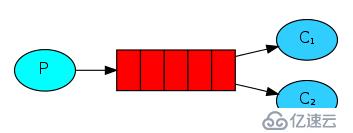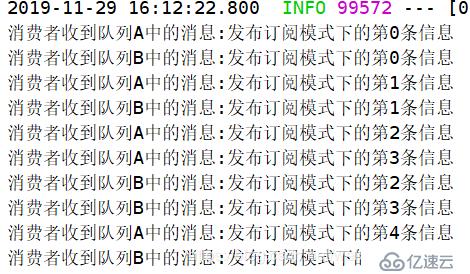@[toc]
erlang开发,并发能力强。
社区活跃,使用的人多,稳定性较强。
延时低
erlang语言开发的,国内精通的不多,日后定制开发困难。

简单模式是Rabbit MQ最简单入门的案例,其中一个生产者,一个消费者。无需声明交换机(其实是有个默认的交换机),声明完一个队列以后,生产者往这里发送,消费者则监听该队列,对消息做出响应。
应用场景:如两个用户之间的聊天。

工作队列模式在工人之间分配任务(竞争的消费者模式),就是有多个消费者的简单模式,多个消费者一起监听该队列,Rabbit MQ 会确保队列中的某一条消息只会被某一个消费者消费。
应用场景:如多个用户抢某个订单(高并发下争抢同一个资源的记得考虑加锁)

发布/订阅模式一次向许多消费者发送消息,还是一个生产者多个消费者,但是该模式需要显示声明交换机了,将创建的多个队列与该交换机进行绑定,生产者将消息发给交换机,由交换机发给已经绑定好的队列,对应的某队列的消费者消费该队列中的信息。
应用场景:群发某个邮件,推送某条广告

路由模式是有选择地接收消息,还是显示声明交换机,将队列与交换机绑定,由生产者将消息发给交换机,由交换机发给对应的队列,由对应的消费者消费信息。但是队列绑定交换机时需要指定一个routingkey ,这样的话,生产者再向生产者发消息的时候,会判断具体的 routingkey 值,并将符合对应 routingkey 值的消息发送给对应的队列。
应用场景:封装若干类错误类型通知

主题模式根据模式(主题)接收消息,同路由模式一样,只不过不再是根据具体的 routingkey 值做判断,是根据 routingkey 值模糊匹配的。其中,星号代表多个单词 , 井号代表一个单词。
更加详细的资料可访问官网 : RabbitMQ官网
fanout模式:不处理路由键,即没有 routingkey 值,很像子网广播,每台子网内的主机都获得了一份复制的消息。
direct模式:处理路由键,需要路由键匹配才能转发,即完全匹配上 routingkey 值。
topic模式:处理路由键,需要路由键模糊匹配才能转发,即模糊匹配上 routingkey 值。
RabbitMQ 依赖与 erlang 语言,点击 官网下载链接 下载 erlang。
点击 官网下载链接 下载RabbitMQ。
安装两者的时候,一路默认设置即可。
启动 RabbitMQ 服务,cmd模式下输入,进入默认安装路径
C:\Program Files (x86)\RabbitMQ Server\rabbitmq_server-3.6.10\sbin输入命令
rabbitmq-plugins enable rabbitmq_management服务启动成功,如图所示
点击 http://localhost:15672/ ,如下图所示


pom.xml中新增
<dependency>
<groupId>org.springframework.boot</groupId>
<artifactId>spring-boot-starter-amqp</artifactId>
</dependency>application.properties中加入
# RabbitMQ
spring.rabbitmq.host=127.0.0.1
spring.rabbitmq.port=5672
spring.rabbitmq.username=guest
spring.rabbitmq.password=guest
# 并发消费者的初始化值
spring.rabbitmq.listener.concurrency=10
# 并发消费者的最大值
spring.rabbitmq.listener.max-concurrency=20
# 每个消费者每次监听时可拉取处理的消息数量
spring.rabbitmq.listener.prefetch=5简单模式和工作队列模式没有指定交换机,rabbitMQ的精妙之处不能体现出来,而路由模式和主体模式都有 routingkey 值,故挑其一,本文以发布/订阅模式和路由模式为例,其余的都可类比。不全写,是因为这是快速上手使用系列,最短的时间精力明白来龙去脉,才是该系列的宗旨,人类畏惧晦涩冗长的,喜欢简短直接的。
新增代码后的目录如下所示

RabbitConfig.java
package com.example.config;
import org.springframework.amqp.core.*;
import org.springframework.context.annotation.Bean;
import org.springframework.context.annotation.Configuration;
@Configuration
public class RabbitConfig {
//==============发布/订阅模式==============
//队列A
@Bean()
public Queue queueA() {
return new Queue("fanoutQueueA");
}
//队列B
@Bean()
public Queue queueB() {
return new Queue("fanoutQueueB");
}
//发布订阅模式下的 fanout 交换机
@Bean
public FanoutExchange fanoutExchange() {
return new FanoutExchange("fanoutExchange");
}
// 把 队列A 和 fanout交换机 绑定在一起
@Bean
public Binding bindingWithQueueA() {
return BindingBuilder.bind(queueA()).to(fanoutExchange());
}
// 把 队列B 和 fanout交换机 绑定在一起
@Bean
public Binding bindingWithQueueB() {
return BindingBuilder.bind(queueB()).to(fanoutExchange());
}
//==============路由模式==============
//队列C
@Bean()
public Queue queueC() {
return new Queue("directQueueC");
}
//队列D
@Bean()
public Queue queueD() {
return new Queue("directQueueD");
}
//发布订阅模式下的 direct 交换机
@Bean
public DirectExchange directExchange() {
return new DirectExchange("directExchange");
}
// 把 队列C 和 direct交换机 绑定在一起
@Bean
public Binding bindingWithQueueC() {
return BindingBuilder.bind(queueC()).to(directExchange()).with("directRoutingkey");
}
// 把 队列B 和 direct交换机 绑定在一起
@Bean
public Binding bindingWithQueueD() {
return BindingBuilder.bind(queueD()).to(directExchange()).with("directRoutingkey");
}
}RabbitController.java
package com.example.controller;
import com.example.service.IRabbitProducerService;
import org.springframework.beans.factory.annotation.Autowired;
import org.springframework.stereotype.Controller;
import org.springframework.web.bind.annotation.RequestMapping;
@Controller
@RequestMapping("rabbit")
public class RabbitController {
@Autowired
private IRabbitProducerService rabbitProducerService;
@RequestMapping("/fanout")
public void fanout() {
for (int i = 0; i < 5; i++) {
this.rabbitProducerService.producerFanout("发布订阅模式下的第" + i + "条信息");
}
}
@RequestMapping("/direct")
public void direct() {
for (int i = 0; i < 5; i++) {
this.rabbitProducerService.producerDirect("路由模式下的第" + i + "条信息");
}
}
}IRabbitProducerService.java
package com.example.service;
public interface IRabbitProducerService {
void producerFanout(String message);
void producerDirect(String message);
}RabbitProducerServiceIml.java
package com.example.service;
import org.springframework.amqp.rabbit.core.RabbitTemplate;
import org.springframework.beans.factory.annotation.Autowired;
import org.springframework.stereotype.Service;
@Service("rabbitProducerService")
public class RabbitProducerServiceIml implements IRabbitProducerService {
@Autowired
RabbitTemplate rabbitTemplate;
public void producerFanout(String message) {
rabbitTemplate.convertAndSend("fanoutExchange", null, message);
}
public void producerDirect(String message) {
rabbitTemplate.convertAndSend("directExchange", "directRoutingkey", message);
}
}IRabbitConsumerService.java
package com.example.service;
public interface IRabbitConsumerService {
void consumerFanoutA(String message);
void consumerFanoutB(String message);
void consumerDirectC(String message);
void consumerDirectD(String message);
}RabbitConsumerServiceIml.java
package com.example.service;
import org.springframework.amqp.rabbit.annotation.RabbitListener;
import org.springframework.stereotype.Component;
@Component
public class RabbitConsumerServiceIml implements IRabbitConsumerService {
@RabbitListener(queues = "fanoutQueueA")
public void consumerFanoutA(String message) {
System.out.println("消费者收到队列A中的消息:" + message);
}
@RabbitListener(queues = "fanoutQueueB")
public void consumerFanoutB(String message) {
System.out.println("消费者收到队列B中的消息:" + message);
}
@RabbitListener(queues = "routingQueueC")
public void consumerDirectC(String message) {
System.out.println("消费者收到队列C中的消息:" + message);
}
@RabbitListener(queues = "routingQueueD")
public void consumerDirectD(String message) {
System.out.println("消费者收到队列D中的消息:" + message);
}
}启动项目后,浏览器输入 http://localhost:8080/rabbit/fanout ,(虽然前台会报错,因为这个请求只是触发消息的生产,并没有对应的界面展示。生产出来的消息经过交换机传给队列,消费者则监听队列,做出对应的响应。)发布/订阅模式下使用 fanout 交换机生产消费消息的效果图如下所示;

浏览器输入 http://localhost:8080/rabbit/direct ,发路由模式下使用 direct 交换机生产消费消息的效果图如下所示;

注:如果是根据本文系列文章来的,因为一开始就配置好了spring security,所以记得将该地址配给所登录的用户。或者开一个超级管理员账号,可以访问项目的任意目录,使用该管理员账号访问这些地址。
到这里,篇幅已经很长了,本来想准备写完死信队列,和消息确认机制。想想这是快速整合上手系列,就把深入的内容放到踩坑深入系列,尽情期待后续开辟新的系列文章吧。
亿速云「云服务器」,即开即用、新一代英特尔至强铂金CPU、三副本存储NVMe SSD云盘,价格低至29元/月。点击查看>>
免责声明:本站发布的内容(图片、视频和文字)以原创、转载和分享为主,文章观点不代表本网站立场,如果涉及侵权请联系站长邮箱:is@yisu.com进行举报,并提供相关证据,一经查实,将立刻删除涉嫌侵权内容。